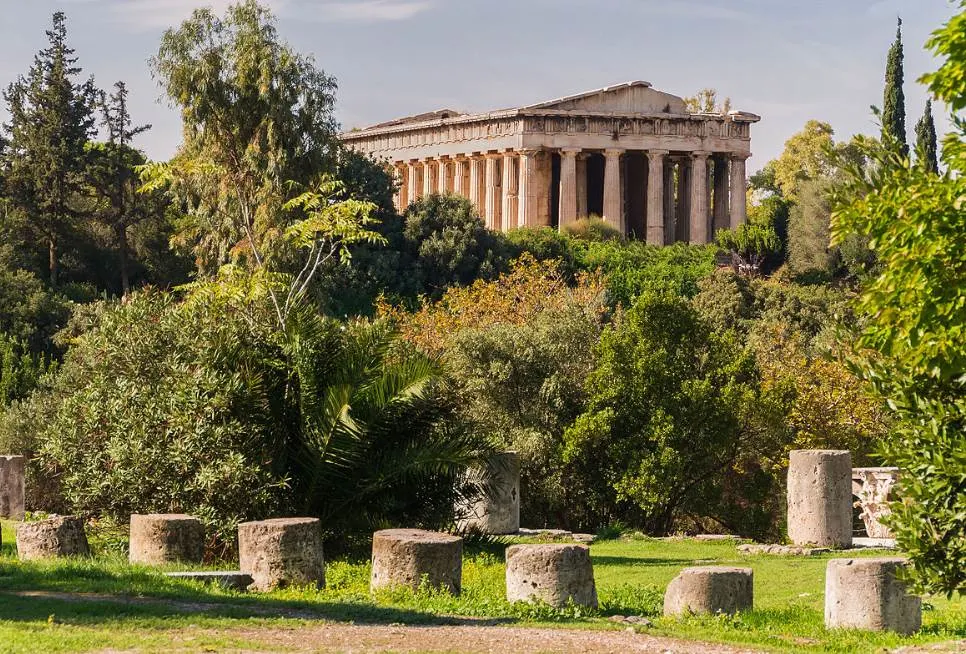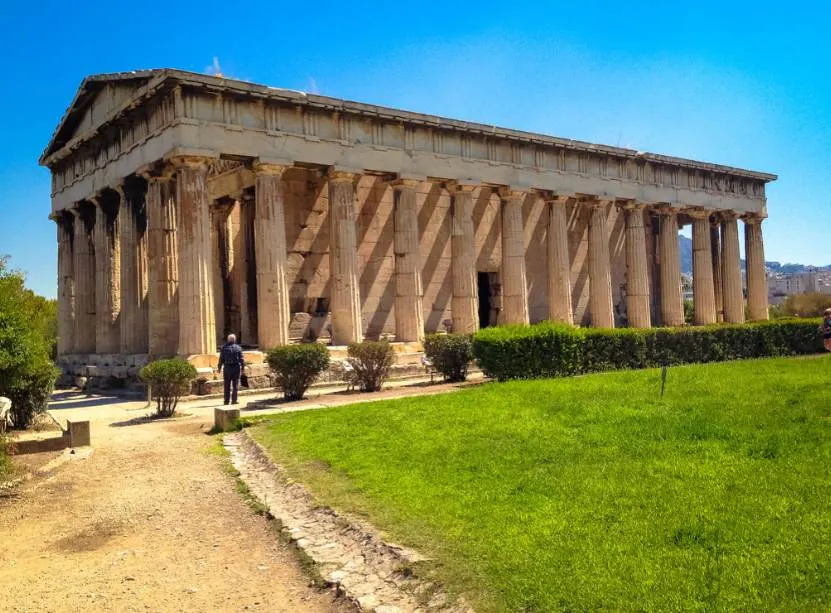Because many ancient Greek Temples were constructed well over 2,000 years ago, not many remain intact today.
This makes the ones that did survive through the centuries quite special, including this amazing structure in Athens.
In this article, you’ll discover some of the most interesting facts about the Temple of Hephaestus, an incredible landmark in the Greek capital.
1. It’s located just northwest of the most famous hill in Greece
The Temple of Hephaestus is one of the many amazing attractions in Athens, the capital city of Greece, and is located in the heart of the city.
It’s situated on top of a relatively small hill known as Agoraios Kolonos hill and about 1 kilometer (0.6 miles) northwest of the famous Akropolis.
This means that you can get an amazing view of this Doric temple when you visit this famous hill in Athens best known for being the home of the Parthenon.

2. It was part of the main public space of the ancient Greek city
The temple held a prominent spot in ancient Athens, even though it was overshadowed by the structures situated on top of the Akropolis.
The reason is that it was located on the northwestern corner of the ancient Agora of Athens, the main public space in the ancient city.
An agora is the equivalent of the Roman Forum, the main public space in cities all across the ancient Roman Empire.

Just like public squares in modern cities, this place used to be bustling with people and commercial activities in ancient times. Nothing more than ruins of the agora remain today.

3. The temple was named in honor of the deity it was dedicated to
For a very long time, the temple was referred to as the “Temple of Theseus or “Theseion.”
That’s because it was believed to be used as the final resting place of Theseus, the Athenian hero and mythical founder of the city.
More recent studies concluded that this wasn’t the case because inscriptions that were found inside the temple mention that it was dedicated to Hephaestus.
He was the ancient Greek god of the blacksmiths and metalworkers, as well as other craftsmen such as carpenters and sculptors. It was also dedicated to Athena Ergane, the patron of craft and weaving.

4. The building was constructed in the 5th century B.C. and took 3 decades to complete
Many ancient Greek temples were destroyed during the Greco-Persian Wars in the 5th century B.C.
Although they initially swore to leave the temples in ruins as a reminder of the wars, this quickly changed when Pericles came to power.
This influential politician had grandiose plans for rebuilding the city of Athens and he is believed to have initiated the construction of the Temple of Hephaestus.
The construction of this magnificent temple started around 449 B.C. and wasn’t completed somewhen during the Peace of Niklas (421-415 B.C.), probably over 3 decades later.
So why did it take so long to complete the temple?
Because most of the efforts were being redirected to the construction of the Parthenon, the magnificent temple on top of the Akropolis that was being built around the same time.

5. It’s one of the best surviving examples of Doric architecture
The temple was constructed in the Doric style and features a so-called peripteral design. That’s a type of temple that is flanked by a single row of columns on all sides.
It features a portico and the interior leads up to a central chamber that houses cult images dedicated to Hephaestus and Athena Ergane. This room probably featured bronze sculptures of Athena and Hephaestus in ancient times.
The upper section of the interior is decorated with friezes in both the Ionic and Doric styles. It features scenes of Hephaestus battling Minotaurs and Theseus in battle with the Pallantides.
The Doric style can easily be recognized because of the circular capitals on top of the columns. It’s one of the three main orders in ancient Greek architecture and the Temple of Hephaestus is one of the best surviving Doric temples in the world.

6. How big is the Temple of Hephaestus?
It took approximately 3 decades before the temple was completed, but that’s not because it’s such an enormous structure.
The marble to build the temple was excavated from the nearby Mount Pentelelicus just northeast of Athens, the sculptural decorations also feature Parian marble.
The short sides of the temple feature 6 columns (east and west) and the long sides 13 columns (north and south). The temple has dimensions of 13.71 x 31.78 meters (44.98 x 104.26 feet).

7. The building was used for different purposes until the 20th century
One of the main reasons why many ancient structures have been preserved so well, apart from the durable materials they were constructed in, is that they served other purposes.
Some great examples are the Pantheon in Rome which became a Catholic church and the Castel-Sant’Angelo which became a castle of the Popes.
The Temple of Hephaestus was transformed into a Greek Orthodox church around 700 A.D. that was dedicated to Saint George. It served this purpose until the year 1833 which is quite astonishing.
It subsequently became a burial place for non-Greek people, including several Englishmen, who lost their lives during the Greek War of Independence between 1821 and 1830.
King Otto I ordered the building to be used as a museum in 1834 and it served this purpose for a century until 1934.
After the museum was closed it was used for archaeological research and now serves as an amazing tourist attraction in Athens.

8. The temple served as the inspiration for numerous buildings worldwide
Because the temple has been reserved so well, it has served as a great source of inspiration for Neoclassical buildings in many parts of the world.
Some of the greatest examples are:
- Monument to Sir Alexander Ball, (1810), Valletta, Malta – A small Neoclassical monument.
- Dundalk Courthouse (1813), Dundalk, Ireland – A judicial building in Dundalk.
- Old Royal High School (1829), Edinburgh, Scotland – A building in Edinburgh on Carlton Hill.
- McKim Free School (1833), Baltimore, Maryland, US – A historic school building in Baltimore.
- Penshaw Monument (1844), Penshaw, Tyne and Wear, England – A monument on top of a hill in Sunderland.
- Old Montgomery County Court House (1844–50), Dayton, Ohio, US – A replica of the temple known as the “Old Courthouse.”
- Vermont State House (1857–59), Montpelier, Vermont, US – The amazing seat of the Vermont General Assembly.

